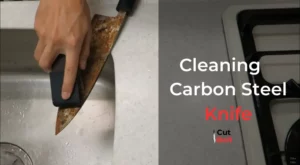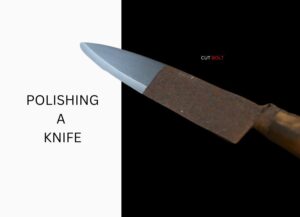Sharpen your kitchen knives before using them. It takes a bit of practice to properly sharpen your knives, so be patient and keep practicing. Today we will discuss how to sharpen a serrated knife.
Whetstone sharpening is the best way to sharpen straight-edged knives. However, for knives with serrated edges, using a whetstone won’t sharpen those serrations and make the knife act like a regular chef’s knife. To sharpen serrated knives, you need to use a sharpening steel.
Maintaining a sharp knife is an especially daunting task for the home chef since the cutting board can make the job more difficult. However, if you follow the suggestions from the experts, you will be sharpening your kitchen knives like a professional in no time.
What is a Serrated Knife, Exactly?
Any knife with “teeth” along the cutting edge of the blade is considered a serrated knife. The cutting action of a serrated blade is different than that of a straight-edged knife, as it’s designed to “saw” through tough foods without crushing delicate interiors, like crusty loaves of bread.
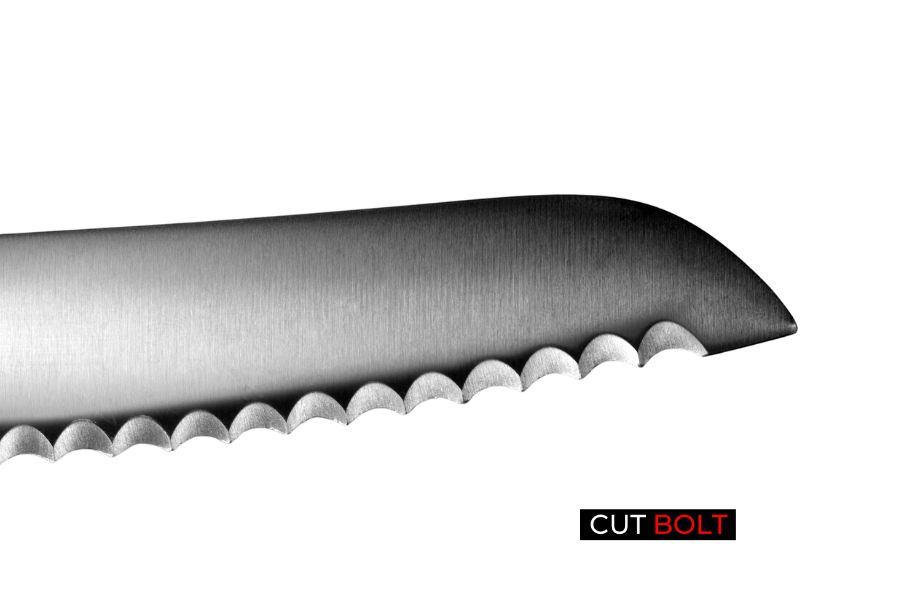
There are a few different types of serrated edge:
Classic Serrated Knife: A classic serrated knife is one with a wide array of points or teeth that give the knife a serrated appearance. It may look similar to a regular knife, but its tooth-like shape actually dulls slower than a regular knife.
Scalloped Serrated knife: Scalloped knives feature small sharp protrusions which protrude from the blade. They’re also surrounded by grooves that run down the knife’s side. In terms of appearance, they look like little teardrops. The blade is much thinner than a traditional knife, and it is used for slicing bread and vegetables.
These knives are easier to handle and have a greater degree of “bite” making them ideal for use with a wider variety of foods.
Double-Serrated: Double-serrated knives are not new. However, the double serration feature has been around for quite some time. The problem is that people generally don’t know how to use it effectively. You can think of it like this: You could use a traditional knife that has rounded edges or a traditional knife that has scalloped edges. But what if you also had rounded edges? And a scalloped edge? That would be an extra set of serrations – double serrations – to give you the best of both worlds.
However, only a few professional chefs actually opt for these kinds of knives over the simpler options.

Wavy Serrated knives: Wavy blades do not have pointed tips rather they have smooth wavy serration. Though wavy serrated knives are not for versatile performance, they can easily outperform classic serrated knives.
Why Use A Serrated Knife At All?
A lot of people don’t know how to use their serrated knife, but it’s actually a great kitchen tool. Serrated knives cut in unique ways and each one does something a little different. Take some time to learn what they’re good for and you’ll find your cooking time a bit shorter.
Serrated knives are used to cut soft ingredients like tomatoes, loaves of bread, cooked steaks and other similar foods. Different serrated knives have a wide range of uses and they can handle their job well.
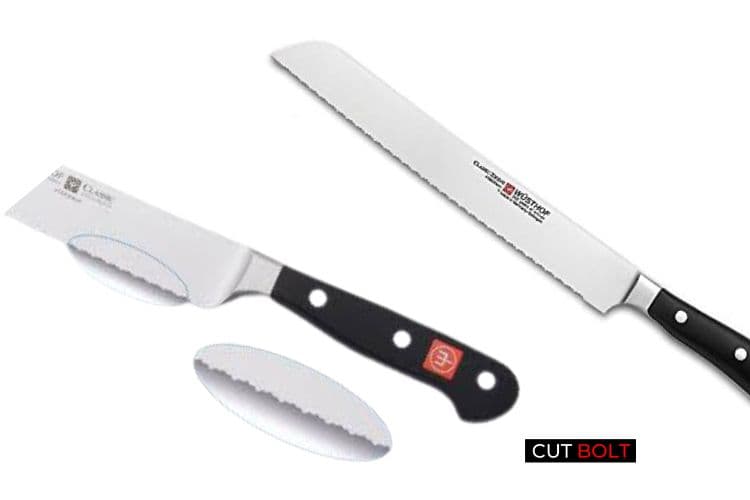
Few Common Serrated Knives:
Here are some common serrated knives that we use in our day to day life:
Bread Knives
The bread knife is not only a versatile knife, but it is also a fun kitchen tool. A serrated edge means that bread does not stick when sliced, while a curved tip helps keep the blade from cutting into your hands.
If you test between straight-edged and serrated knives, you will find that a serrated knife is a better choice to cut bread without making a mess of it.
I often use my bread knife to cut soft fruits like melons, tomatoes, and pineapples.

Steak Knives
Serrated steak knives were invented as a response to steak knife manufacturers who found that customers wanted to be able to shave thin slices from their steak, which had previously been difficult with a plain-edged knife. Although there are no studies available to support the claim, it has also been suggested that serrations are used to prevent accidental cuts during sharpening or accidental contact with the meat.
In the same way that the most effective steak knives are those with a straight edge, the best knives are the ones that will allow you to slice through your meats with ease. This can be accomplished by slicing through your meats rather than by tearing them apart and having your food spill everywhere. With this information, it is important to find the best steak knives.
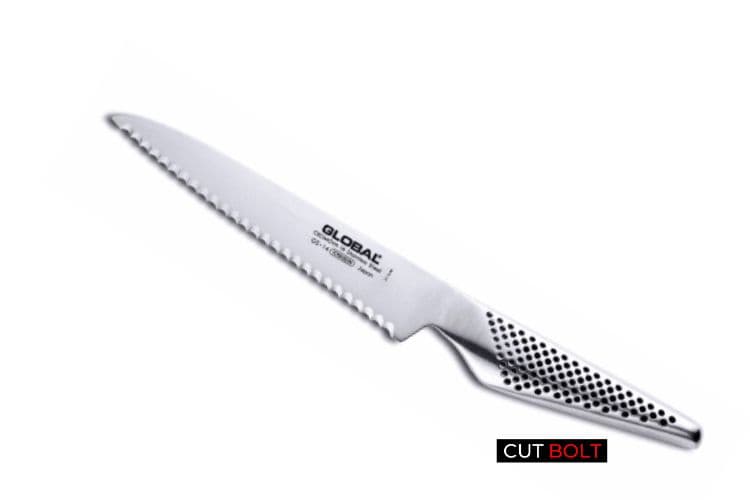
Utility Knives
Utility knives are versatile multipurpose tools. They are very handy for many tasks around the kitchen. Most foods don’t have their own knives so they’ll usually use a utility knife first.
Utility knives are small in size and do their job well. They are mostly used for quick presentation cuts (like slicing a sandwich in a presentable manner before they are served).
Like steak knives, a utility knife can be serrated or non-serrated. Whether serrated or non-serrated you can use it to cut and carve a variety of things from a large number of materials.
How To Sharpen A Serrated Knife
If you want to sharpen your serrated knife, the traditional way is to use a ceramic honing rod to hone the blade. You can’t use an electric knife sharpener or other honing tools with this type of blade, though some high-end electric knife sharpeners feature a serrated knife slot.
Here’s how to use a honing rod to sharpen a serrated knife: Notice that your knife has a flat and a beveled side. The beveled side is used to cut and we are going to sharpen this side only.
The rod must be run through each gullet. Serrated knife sharpening requires each section between the serrations to be sharpened. There is no shortcut to it.
Place the honing rod flat on the beveled edge and run it through the gullet to the cutting edge. Ensure you keep the angle correct and place the sharpening rod along the bevel only.
You can speed up the process by using a sharpening stone and sharpening the edges at the same time.
Remember you will need to remove all the burrs (pieces of metal that come out while sharpening). Use a whetstone or sandpaper is suitable for it. Make sure that the edge of the blade is perpendicular to the stone.
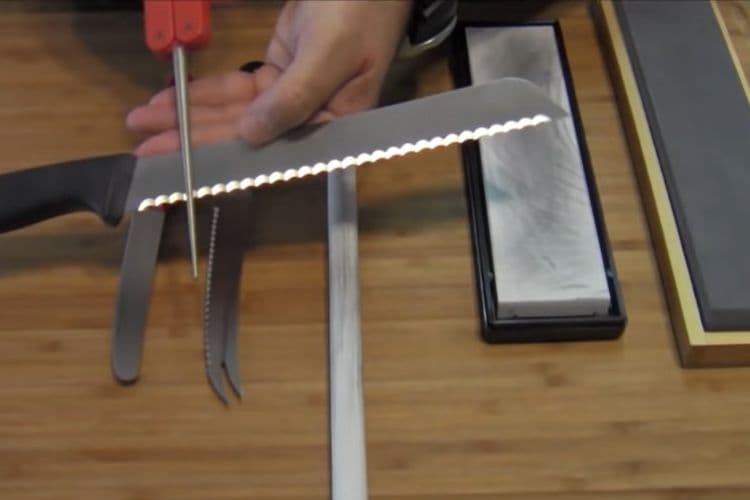
Sharpening A Serrated Knife In Three Easy Steps:
For sharpening a serrated blade you’ll need a tapered diamond or ceramic knife sharpening rod, and a permanent marker. The easiest way to do it is to tape the blade, and then trace its outline with a permanent marker.
Step 1: Use the honing rod matching the grid angle
To start using a knife sharpening rod, you’ll need to measure the length of the rod (usually around 18 inches long).
The first step is to find your grinding angle. Use your marker to color the grinds of the serrations. This will help you to find the angle at which the serrations are ground into the blade. Most are ground from one side of the blade, which is called a chisel grind.
Make sure to use the angle of the blade against the serration, and try to match the width of the blade to the width of the serration. Different serrations will utilize different portions of the taper.
After your knife has been sharpened, it is time to move to the side of your knife to make some short, light strokes to see where the marker is worn away. This will give you an idea of how to adjust your angle and position on the tapered sharpening rod.
Don’t hit the whole center. You’re only going to get the best results if you start hitting the sides, then the top of the grind, and finally the whole center. The grind has to be slightly off, too.

Step 2: Create a Burr
Knives get dull because of damage caused by wear and tear. To repair that, we need to raise a burr. A consistent burr indicates the knife is being sharpened correctly. By raising the burr we mean removing the dullness of the knife. You can feel the burrs on the opposite side of the currently sharpening side. We raise the burr and refine the edge to make it smooth and sharper.
Use a tapered ceramic rod for short strokes and for long strokes use the non-tapered ceramic rod. The other way to sharpen is to put the rod inside each gullet and spin the rod with your fingers. Continue the process until the damaged or dull steel is removed.
As you continue the process for each gullet of the knife, you will notice the edge is folded over the entire serration. It indicates you are done with the sharpening part. Now it is time to refine the edge by removing the burr in the next step.
Step 3: Refine the edge by removing the burr
The tough part of sharpening a serrated knife is done. Removing the burr is easy and simple.
To remove the burr, take your rod and go to the side of the blade that isn’t ground.
Hold the honing rod at around a 10-degree angle and slowly pass it over the burr (from the flat side of the serrations). Remember not to use too much pressure as we intend to remove the burr with little pressure so it breaks off.
Once done, you will find a much-refined edge and the knife is sharp.
You can tell when your blades are in the correct condition because they look perfectly smooth.

You can also read about the Japanese Honbazuke sharpening method.
Useful tips for sharpening serrated knives:
Don’t Go Overboard
Don’t be tempted to make long strokes. A tapered rod is meant to be used for short, controlled strokes. If you make a long stroke, your serration will have a crater in the middle. It can damage the knife.
Speed up your serrated knife sharpening
This is an old trick I learned from a friend who was a machinist. I’ve been using this trick since the early 1980s.
We all want to get the job done, but sometimes we need to get it done right, and not fast. When you have the right tools, it can help you get the job done faster, but if you have the wrong tool, it can actually slow you down.
Instead of spinning the tapered rod with your hand, you can use a cordless drill, fix the rod on the drill and put it on low speed. As you need to sharpen every gullet of the knife, using a drill can help you complete the sharpening faster. But be careful not to ruin the blade.

Don’t injure your fingers
When working on the rod, it’s important to watch your fingers. If you have your finger over the rod and then try to put pressure on the blade, you’re going to have trouble keeping control of the rod. It’s a good idea to have a grip on the rod so that you don’t lose control of it. The same goes for the blade, so try to keep your hand away from it. When you reach the tip, use a very light touch.
Frequently Asked Questions About Serrated Knife Sharpening
Why do they call them “serrated”?
A serrated knife has a row of sharp teeth along the edge of the blade.
What is a serrated knife?
A serrated knife has a series of small, sharp teeth along the edge of the blade. This makes it easier to cut through things.
Do all knives have serrated edges?
No. Most knives don’t have serrated edges.
What are the benefits of a serrated knife?
The main benefit of a serrated knife is that it is easier to cut through tough materials.
What are some common uses for a serrated knife?
Serrated knives are commonly used to cut through bread, bagels, and other foods. They can also be used to cut through tough materials such as leather.
What are some things to avoid when using a serrated knife?
You should avoid using a serrated knife on hard surfaces such as glass, porcelain, and ceramic.
Are there any drawbacks to using a serrated knife?
There are no drawbacks to using a serrated knife. A serrated knife has its own purpose, if you using for the correct purpose, there are no drawbacks.
What is the difference between a serrated knife and a regular knife?
A serrated knife has teeth along the edge of the blade. The teeth help to cut through foods that are difficult to cut with a straight knife. A plain knife has no teeth.
What are some uses for serrated knives?
You can use a serrated knife to cut through cheese, bread, and other foods.
What is the best way to sharpen a serrated knife?
Best way to sharpen a serrated knife is to use a sharpening rod. I recommend manual sharpening instead of using an electric knife sharpener.
What is the best brand of serrated knives?
The best brand of serrated knives is Victorinox.
Why do I need a serrated knife?
Serrated knives can be used for cutting tomatoes, cooked steaks and pieces of bread. They are also used to cut through tough materials such as leather and rope.
What are the advantages of using a serrated knife?
A serrated knife is easier to use than a straight knife because it is more precise and cuts faster.
What are the disadvantages of using a serrated knife?
A serrated knife may not be as sharp as a straight knife. It is also harder to sharpen.
What is the best way to use a serrated knife?
A serrated knife should be used in a slicing motion. Use the serrated edge to cut and then move to the blunt end to push through.
What’s the best way to use a serrated knife?
The best way to use a serrated knife is to hold it in your right hand and place the tip of the blade between your thumb and index finger. Then, slide your fingers down the handle and bring the blade up towards your body.
Is it true that a serrated knife is more dangerous than a straight knife?
It depends on the knife. If the knife is sharp, it can be very dangerous. If the knife is dull, it is not as dangerous.
What are some other ways to cut food with a serrated knife?
You can cut food with a serrated knife by placing the tip of the blade in between your thumb and index finger. Then, slide your fingers down the handle and bring the blade up towards your body.
What are some other ways to cut food with a straight knife?
You can cut food with a straight knife by placing the tip of the blade in between your thumb and index finger. Then, slide your fingers down the handle and bring the blade up towards your body.
How many teeth should there be on a serrate knife?
There should be at least 10 teeth on the cutting edge of the blade.
Are serrated knives sharp?
Yes, serrated knives are sharp.
Can you sharpen a serrated knife?
Yes, you can sharpen a serrated knife. You will need a sharpening rod for sharpening and a sharpening stone to remove the burrs and give the knife a polished look.
Can I use an electric knife sharpener on a serrated blade?
Yes, you can use an electric knife sharpener on a serrated blade. But, all the electric knife sharpeners are not suitable for serrated blades. Some sharpeners have a special slot for serrated knives. Keep in mind that sharpening a serrated blade needs superior control on the sharpener as well as on the knife. If you lose control, it can ruin the knife. Check before you buy.
How can I sharpen a serrated knife without any special tools?
You can sharpen a serrated knife without using any special tools. Use a sharpening rod to get the result.
Final words: Serrated knife sharpening
One of the reasons that knives get dull is because the metal gets worn down over time. The sharpener is not the only thing that will wear down the knife; things like the blade getting stuck in a piece of food or the user accidentally hitting the blade with a hard object will also contribute to dulling. So, one of the best ways to ensure that your knife stays sharp is to keep it clean and sharpen it regularly.
Sharpening a serrated knife is not as difficult as it seems. The key is to use the correct technique.
If you have questions on how to sharpen a serrated knife, let me know in the comments.

